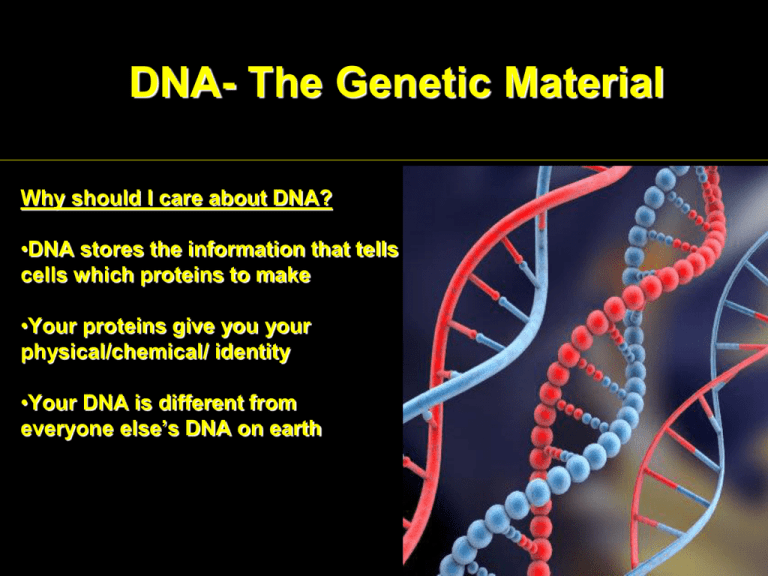DNA- The Genetic Material
advertisement

DNA- The Genetic Material Why should I care about DNA? •DNA stores the information that tells cells which proteins to make •Your proteins give you your physical/chemical/ identity •Your DNA is different from everyone else’s DNA on earth Does DNA have anything to do with why I am so special? •Yes, it’s the variability of DNA that makes us all different! Who Discovered the Structure of DNA? James Watson & Francis Crick discovered the structure of DNA after observing an X-ray picture of it taken by Rosalind Franklin The Structure of DNA DNA is composed of 2 connected nucleotide chains Sugar-Phosphate backbone, with bases in the middle 4 Bases Adenine Guanine Cytosine Thymine Bases complement one another A bonds to T, G bonds to C (bases bond together by hydrogen bonds) The two strands are twisted together Structure of DNA Additional DNA Facts •Shape of DNA is a Double Helix (a Twisted Ladder) •Sugar in DNA = Deoxyribose •1 base + 1 phosphate + 1 sugar = Nucleotide Nucleotide Deoxyribose DNA Replication Why does DNA replicate? •Cells get worn out, new cells must be made •New cells must make exact copies of themselves •Copies of replicated genes can be passed on to offspring How is DNA Replicated? 1. Helicase breaks hydrogen bonds in the middle of the strand, creating a replication fork 2. Unpaired bases form new bonds with free nucleotides in the cell 3. New strand is rewound together by DNA Polymerase, creating 2 identical DNA molecules 4. Sometimes replication errors make a mistake (A bonds to a G); DNA polymerase usually proofreads the strand There are 3 x 109 bases in the average cell Takes about 4 hours for a cell to replicate its DNA DNA Replication DNA Replication Transcription DNA is the material used to make proteins DNA is located in the nucleus of the cell Proteins are made in structures called ribosomes, in the cytoplasm of the cell DNA CANNOT leave the nucleus of the cell because it is double stranded Transcription Mr. DelPrato I am afraid for the DNA, it can’t get to the ribosome! What I am to do? Relax, RNA is the key! What is RNA? •A nucleic acid that is similar to DNA •Ribose is the sugar •Instead of thymine, Uracil •Single stranded Steps of Transcription 1. DNA strand unwinds (helicase) 2. Free nucleotides bond to bases, except U in RNA bonds to A from DNA 3. RNA polymerase joins single stranded RNA together 4.Messenger RNA (mRNA) moves to the ribosome in the cytoplasm (or on the Rough ER) Transcription 2 Models of Transcription Transcription Animation of Transcription! http://www.johnkyrk.com/DNAtranscription.html Translation (Protein Synthesis) What is protein synthesis? The Conversion of RNA to Amino Acids, which make up proteins Why is it called translation? The genetic code (ATCG) is translated into a protein Where does it occur? At the ribosome in the cytoplasm Globular Protein found in Human Blood (serum albumin) How Does it Happen? 1. Initiation A. Ribosome attaches to mRNA (each 3 bases is called a codon) B. tRNA brings anticodon and AA to ribosome 2. Elongation A. More tRNA’s bring more AA’s to ribosome B. AA’s connected together to make polypeptides (by peptide bonds) 3. Termination A. Ribosome reaches a STOP signal on mRNA B. Polypeptide (protein) is broken off and becomes part of the human body C. Golgi apparatus modifies completed protein; ER transports it in/out of cell Translation- The Movie Translation Animation Part 2! Translation Animation Scary Translation Scary Animation of Translation! http://www.youtube.com/watch?v=983lhh2 0rGY The processes of transcription and translation are the same in all living organisms! Blue Whale Tarantula Control of Gene Expression in Eukaryotes • In eukaryotes, cells differ in which genes are being expressed based on cell function – ex. nerve vs. muscle. • Genes in eukaryotic cells are turned on and off like a light switch. The genes that are turned on in a muscle cell are different than the genes that are turned on in a nerve cell. • Gene expression is what makes cells different in a multicellular organism Nerve Cell vs. Muscle Cell Gene Mutations • Definition - a change in the sequence of bases within a gene Causes – • Mutations can be spontaneous or caused by environmental influences called mutagens. • Mutagens include radiation (X-rays, UV radiation), and organic chemicals (in cigarette smoke and pesticides). Types of Mutations Frameshift mutations – •one or more bases are inserted or deleted from a sequence of DNA •can result in nonfunctional proteins •can result in no protein at all – stop codon where there shouldn’t be one Point mutations (3 Types) – •One base is substituted for another •May result in change of amino acid sequence •May not affect protein at all Types of point mutations 1. Silent mutation - the change in the codon results in the same amino acid Ex: UAU UAC both code for tyrosine 2. Nonsense mutation - a codon is changed to a stop codon; resulting protein may be too short to function Ex: UAC UAG (a stop codon) 3. Missense mutation - involves the substitution of a different amino acid, the result may be a protein that cannot reach its final shape Ex: Hbs which causes sickle-cell disease Repair of Mutations DNA polymerase proofreads the new strand against the old strand and detects mismatched pairs, reducing mistakes to one in a billion nucleotide pairs replicated. If errors occur in sex cells – mutation may be passed onto offspring If errors occur in body cells - cancer may result




